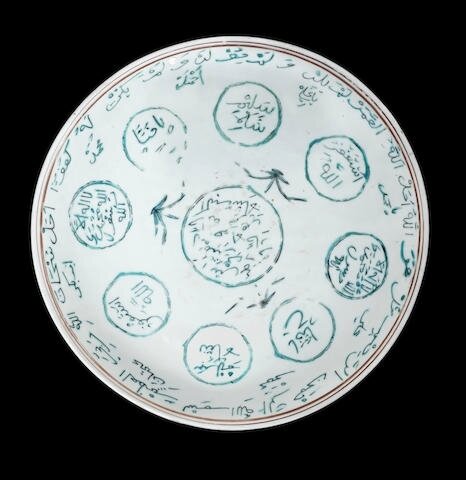of shallow rounded form on a short foot, decorated in turquoise, red and black enamel, a central roundel containing inscription surrounded by three leafy tufts, encircled by eight roundels containing inscription, the rim with a further band of inscription
Provenance: Private French Collection.
Inscriptions: including Qur'an, chapter CXII (al-ikhlas); the shahadah, invocations to God, Muhammad and 'Ali; the names Muhammad, the Four Orthodox Caliphs and the names, 'Akbar Shah' and 'Salim Shah' (parts undeciphered).
Note: Porcelain magic-bowls inscribed in Arabic were produced in China for export to the Muslim communities principally in South-east Asia and India. Two main groups can be identified, one whose manufacture began in the late 16th Century or early 17th Century, the other in the late 18th Century. The inscriptions on those produced earlier testify to their talismanic function while those produced later contain magic squares.
For a similar bowl in the Nasser D. Khalili collection of Islamic Art, see Francis Maddison and Emilie Savage-Smith, Science, Tools and Magic, Part One, London, 1997, p. 103.
Bonhams. ISLAMIC AND INDIAN ART, 25 Apr 2017, 11:00 BST, LONDON, NEW BOND STREET

/https%3A%2F%2Fprofilepics.canalblog.com%2Fprofilepics%2F1%2F0%2F100183.jpg)
/https%3A%2F%2Fstorage.canalblog.com%2F03%2F02%2F119589%2F96711876_o.jpg)
/https%3A%2F%2Fstorage.canalblog.com%2F11%2F31%2F119589%2F94773502_o.jpg)
/https%3A%2F%2Fstorage.canalblog.com%2F20%2F83%2F119589%2F94772815_o.jpg)
/https%3A%2F%2Fstorage.canalblog.com%2F26%2F72%2F119589%2F75604929_o.jpg)
/https%3A%2F%2Fstorage.canalblog.com%2F59%2F60%2F119589%2F26458628_o.jpg)



/http%3A%2F%2Fstorage.canalblog.com%2F76%2F15%2F119589%2F129393400_o.jpg)
/http%3A%2F%2Fstorage.canalblog.com%2F74%2F57%2F119589%2F128709421_o.jpg)
/http%3A%2F%2Fstorage.canalblog.com%2F99%2F76%2F119589%2F126944862_o.jpg)
/http%3A%2F%2Fstorage.canalblog.com%2F97%2F88%2F119589%2F126616983_o.jpg)